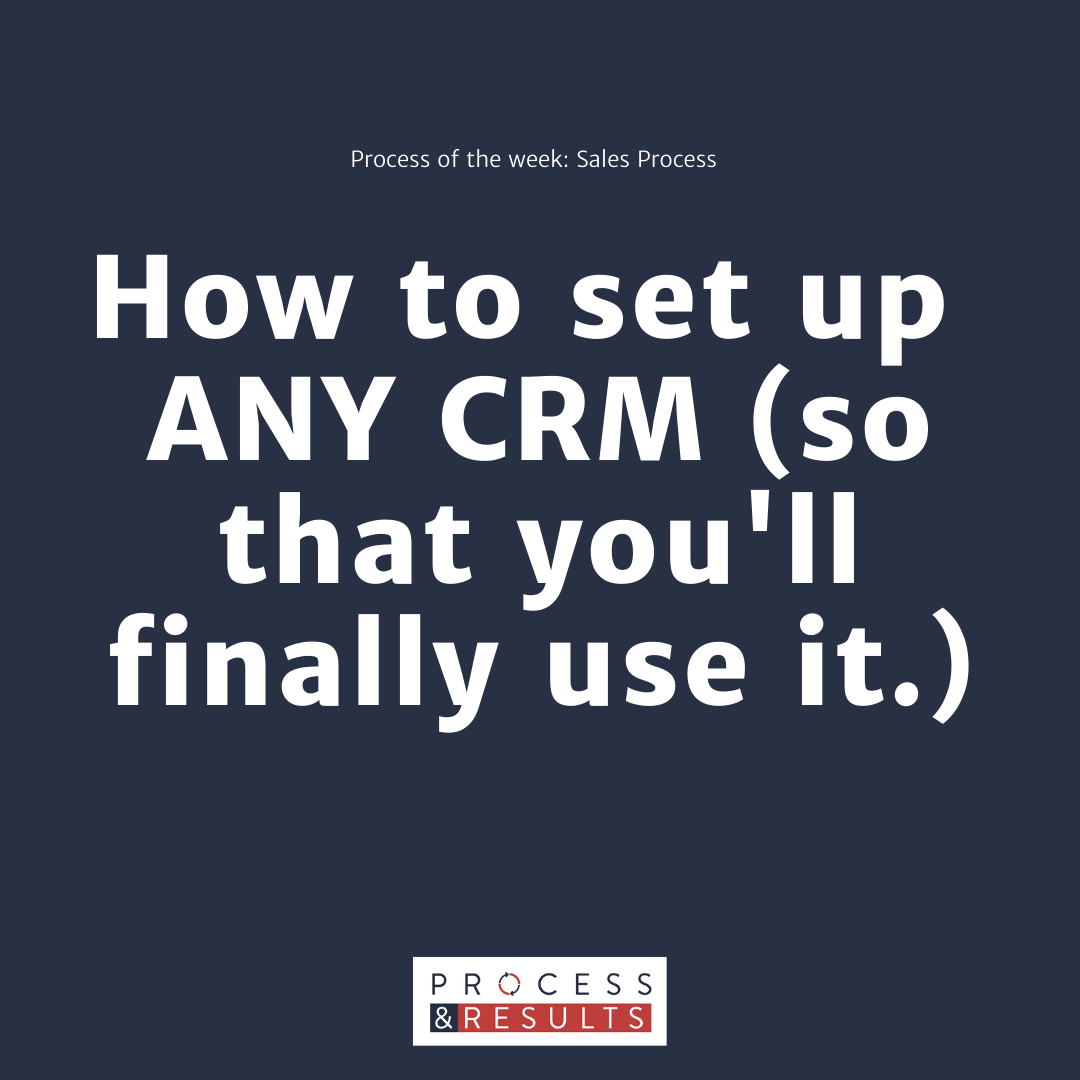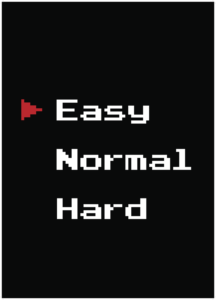
How to set up ANY CRM (so that you’ll finally use it).
There’s an old joke in sales: “Which CRM don’t you use.” And people all have a love-hate relationship with their CRM.
 A lot of people spend a lot of time messing with their CRM tools, but fewer get a good return out of them. And the benefits of using a CRM are huge:
A lot of people spend a lot of time messing with their CRM tools, but fewer get a good return out of them. And the benefits of using a CRM are huge:
- You can serve your customers more efficiently (and save money doing it).
- You can target just interested people (and only uses resources on your buyers)
- You can have a system of record for your business (so you can grow how you want to.)
All of this means that your business is now going to be able to be on “easy mode.” A lot of times people struggle to implement CRM because getting it started can be a mess. We’re here to fix that.
Step 1: Decide What You Want Out of Your CRM.
The first thing you want to do is decide what you want your CRM to do for your business.
Most businesses install (or switch) CRM because they have some vague goal of being “more organized” or “connected” with their customers. Or to even “grow their sales.” These things are all good things. They happen naturally with CRM.
But they aren’t specific enough. When your goal is so vague, it’s not likely to work.
To “stick with” CRM, you have to think of it as an employee that is hired to do a job. The more specific, the better.
Here are some goals that can work for you.
- To (finally) measure what percentage of leads you close.
- To increase sales by 20%
- To move 25% of our customers into our most profitable products.
- To build a sales process with steps so the owner doesn’t have to sell everything.
These are goals that CRM can and will accomplish, and you’ll know if your CRM is working for you if you set it up to do this for you. But if you are going to have a vague goal of “getting better” it’s very unlikely that you’ll get a good return on your CRM.
Step 2: Commit To Using Your CRM – and Schedule Some Learning Time
You won’t get anything out of CRM unless you commit.
And generally, it takes 8-10 sessions with a CRM to learn how to use it properly.
So, schedule these times on your calendar and write down what the tasks are.
You’ll schedule 30-minute sessions for:
- Contact management: how to enter contacts, automate contacts, etc.
- Calendar management
- Activity series.
- Tagging and automation
- Working with Pipelines.
- Working with templates.
- Working with reports.
- Working with integrations
This way you can learn what the CRM can do now, and what it will do for you in the future.
I’d also schedule 1-2 hours a week, every week for CRM maintenance. There will be tasks that you will want to do regularly, such as scan your phone and put the numbers in your CRM, and other tasks that will become apparent to you as you use your CRM.
Step 3: Build Your “Core Four” Plans (on Pen and Paper):
The first thing you’ll want to do is on pen and paper. You’ve added a CRM. Great. Now you want to think in terms of what CRM can do and build out whiteboard or paper processes for the things that it does right. We like to start with four main plans.
- Lead to close: This is what happens when someone goes from being a lead to a client/customer.
- Client To Repeat Client: We want people to be repeat clients, so we want to have a plan to make that happen. How often do we contact them? How do we stay “top of mind” with them?
- Contact to Network: Let’s say we meet someone at a business function, trade show or someplace else. We want to make sure that these opportunities aren’t wasted, so we want to indoctrinate our new contacts in a sensible way.
- Influencer to Raving Fan: We want to plan on making someone a raving fan. What does it take? Do they have to experience our service? Do they have to get a favor? The way we think about this is to think about the people that have given our business the most support over the years and let’s figure out ways to make more raving fans.
These “core four” plans are where we start. Most CRMs will support multi-channel contacts: texting, calling, emailing. Take advantage of all of that so that you can contact people wherever they are.
Each plan will have the steps that someone needs.
Step 4: Decide How You’ll Execute Your Plans & Put Them In Play.
Most CRMS will allow you to work with people contacts via tags, pipelines or activity series. These are common to many CRMs.
We recommend using either tags or pipelines for most of your work because it keeps you in charge.
Tags are versatile when you are really good at planning over the long haul, and can be the most flexible when integrating with other systems. They are also a little trickier to keep track of because they aren’t visual.
Pipelines are great for pushing clients through a linear process. From “lead to close,” or from “client” to “repeat client.” Pipelines are visual, and they are an easy place to start and a lot of CRMs will allow some automation to happen when you drag people from the pipeline to pipeline.
Activity Series: Are great for limited things like onboarding or customer ramp-up. Some CRMs only have this as an option, but they are generally the least flexible. You can’t change them.
Step 5: Put Your VIPs in Your System and Tag Them
Everyone has VIPs. These are the “core” most important contacts in someone’s business. We want to put your VIPs in and tag them as VIPs. We want to start here with our most important folks so we can get used to working with a CRM.
The first thing you do is put your top 20 contacts in there. Tag them. Assign them to your pipelines. Figure out what you want to happen with them.
Now, do everything manually. If you need to “send an email” make this a “task” for now, rather than an email series.
Step 6: Import the rest of your contacts. Tag them “inbox.”
Every decent CRM will support tagging or a close equivalent. When you have an “inbox” tag this means there is something you need to clear out of your inbox. . We want to have tags or categories for at least the following people:
- Active Customers- People that are doing business with you now.
- Contacts– general people that we’re somehow connected with.
- Prospects/Leads- People we are trying to work with right now. These can also be in our pipelines.
- Past Customers- People we’ve worked with in the past.
- Vendors- Our vendors need to be in our CRM as well.
- Competitors- When a competitor comes in, we want to know this.
- Employees/Teammates- Our employees and teammates.
Step 7: Process Your Contacts
Contactually had a great way of doing this called “the bucket game.” It was an innovative and fun addition, and I loved it when I used Contactually.
But every CRM has a way of doing fairly efficiently, we’d just commit to doing this for 15 minutes a day, and we could probably sort through at least 350 contacts an hour or more.
Once they are in we can make individual plans for all of them and always have a “next step” to deepen our relationships.
Eventually, everyone within your CRM will get a plan. We can manage relationships in an “ideal” way.
Step 8: Use Your CRM for what you hired it for.
Lots of times customers will start with CRM but lose track of why they put it in place. The use will fall back and then they will abandon it and conclude “it doesn’t work.”
You hired your CRM to help you accomplish a task. So let’s put it to work so you can get ROI out of it.
If you are using your CRM to go from $15,000 per month to $25,000 per month, use it. If you use it and trust it, it will help your business.
Our suggestions are to commit to the following steps:
- Work with your CRM for 30 minutes a week, 3 days a week, minimum.
- Have a plan in place for every contact type – and execute it.
- Use your CRM as your central hub whenever possible.
Conclusion: Get a CRM & Get Going With It
There are a lot of great CRMs out there.
Our #1 recommendation is Nutshell CRM. It’s the one we use and recommend because it has the best balance of power and usability.
They also have a great blog, and a fantastic community. I’ve used, installed and recommended Nutshell since about 2015, and they have always been kind, gracious and they have shown a great commitment to improving their product
We also like:
- Insight.ly– works really well for people totally committed to the Google ecosystem.
- Close– Works well for people building outbound sales teams for SaaS or consulting.
- Nimble- a fit for people in the Microsoft ecosystem.
Whatever you use, get going with it. Your CRM will be able to extend what you can do with your business and grow things.
- Decide what you want to happen because of your CRM.
- Schedule time to use it.
- Plan what happens to all of your core client groups.
- List your 25 most important contacts.
- Import and process your contacts
- Manage your CRM for 30 minutes 3x a week on a schedule.
Of course, contact us if we can help you do get any of this working for you.
We will be releasing some video content on these steps inside the Nutshell ecosystem. They should help with whatever CRM you use. If you’d like that, please email chris@processandresults.com with the subject “CRM Videos.”
Like this post? Get A New Business Process Every Monday
Join our newsletter, and we'll send you a new business process every Monday.
We cover everything that service businesses need to improve.
